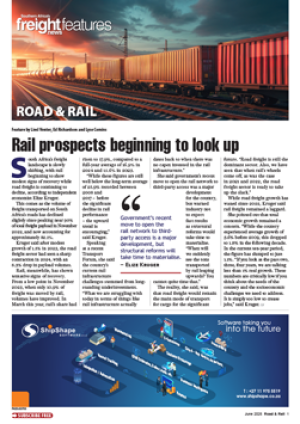As South Africa’s freight demands continue to rise, the country’s road sector remains in the lead, driven by digitisation and innovation, while rail continues its struggles to keep pace, falling short in areas where it should be dominating.According to Renko Bergh, co-founder of logistics technology firm CtrlFleet, digitisation in road transport is no longer a future goal – it’s a current reality. “Driver applications have become the norm and cargo owners’ demand for live track-and-trace platforms continues to grow,” said Bergh. “Transporters not utilising technology in this regard are left in the dark – figuratively and somewhat literally.”This is occurring, however, against the backdrop of a rail sector that continues to underperform. Despite South Africa’s total freight volume reaching 838 million tonnes, rail’s share remained f lat at 25% between 2011 and 2019. Alarmingly, rail’s market share in general freight corridors dropped from 19% to just 11% in the same period.Based on national freight data, rail was expected to deliver 47 billion tonne-kilometres of general freight in 2019, but managed only 18bn tonne-kilometres, leaving a staggering shortfall of 30bn tonne-kilometres. And the challenge is only growing.“The general freight task is projected to rise to 77 billion tonne-kilometres by 2050,” said Bergh. “For rail to absorb that demand, it would have to more than quadruple from its current size. That’s an unlikely transition, which underscores the continued growth, necessity and demand for the road transport sector.”Bergh pointed out that this was not just about underperformance but also missed opportunities. “General freight, especially long-distance palletised cargo, should be a natural domain for rail, yet it’s practically non-existent.”According to Bergh, in 2019 total rail-friendly freight was estimated at 181bn tonne-kilometres, of which approximately 141bn was on rail. This figure is projected to rise to 276bn tonne-kilometres by 2050. In 2019, rail accounted for 78% of rail-friendly tonne-kilometres and 65% of rail-friendly tonnes shipped, revealing a substantial gap where freight that should ideally be transported by rail is instead being moved by other modes.“In other words, 22% of tonne-kilometres that can best be served by rail and 35% of rail-friendly tonnes are currently carried by road, adding significant direct logistics costs and externalities to the economy,” said Bergh. Addressing these gaps presents a major opportunity to expand rail services. According to Bergh, the biggest undeveloped rail service opportunity is in the palletised long-distance freight segment, while the biggest gap relative to existing competencies is in domestic minerals. “With proper rail shift to privatisation, this opportunity can be exposed and transition to rail can be realised.”The first, short-term strategic objective was to create capacity and shift the identified 11 billion tonne-kilometres of rail-friendly export minerals and 30 billion tonne-kilometres of rail-friendly general freight currently on road to rail in the next two years, he said. “The longer-term strategic objective is to ensure that the reform and investment path will facilitate the quadrupling of the general freight railway by 2050. This second strategic objective especially creates a significant opportunity over time for many other players to become involved.”As the rail sector looks to expand and modernise, technology integration will be crucial to improving operational visibility and efficiency.“At CtrlFleet, some of our road transport clients are requesting that we find ways, either via integration or suggesting third-party tracking units to be utilised on rail cargo movement to mimic the execution management on road, but via rail,” said Bergh. “Currently, CtrlFleet links to each transporter’s respective tracking solution and provides a schedule tool, while utilising truck position data from tracking. With rail, however, there is no current available system to link to tracking data, hence third-party applications need to be implemented, where consent is gained.“We anticipate that with rail privatisation, the demand and offering of rail tracking will come to the fore.”But, said Bergh, while hurdles remained, many companies continued to express a clear intent to shift freight to rail. “In some cases, they would do so even given current service level shortcomings. A portion would require more competitive tariffs, but a shift even at current tariffs would have been possible if capacity was made available.” LV

